Optimize your email campaigns by applying best practices
To employ an effective email marketing strategy, you need to take a lot of parameters into consideration, from data management through to configuring email systems and creating personalized experiences. While such interlinked elements may be difficult to address individually, there are some quick and easy best practices you can follow for email campaigns that may have a real impact on their performance and the achievement of your marketing objectives.
To provide you with some guidance for your upcoming campaigns, we’ve put together a summary of best practices to consider throughout your strategy and email campaign planning.
Summary
-
Emails that elicit interest right from the inbox to encourage opens
-
Email that respects accessibility criteria for an optimal user experience
Key elements to consider when planning email campaigns
Efficient segmentation through customer data analysis
The collection and analysis of customer data are foundational pillars of successful segmentation. In a context where third-party data have become problematic, it’s even more important for companies to consider collecting data that are exploitable, since they’re needed to understand your customers and establish effective, relevant segments. More information is available in the article Improve Customer Retention Through Data and Segmentation.
Putting in place effective, relevant segmentation so you can send engaging emails and maximize campaign performance is one of the first best practices you should follow.
Segmentation involves dividing an audience into subgroups based on various criteria—such as customer purchase behaviour, their interests or socio-demographic attributes, etc.—to send more relevant, personalized messages that respond to the needs and interests of each targeted group.
Segmentation lets you offer a more personalized, adapted experience that strengthens the feeling of being part of a privileged relationship, but also improves brand image. Sending “unique” communications instead of mass messages reduces unsubscribes and the dissatisfaction felt by an audience when they receive messages that are irrelevant or inappropriate for certain targeted contacts. More information on this is available in the article Data, the Beating Heart of Relationship Marketing.
|
A few best practices/tactics to consider: - Identify the relevant segments in your audience through data analysis of contacts (recency, frequency of engagement, monetary value, profile attributes, etc.) - Build segments with a number of representative contacts from your audience to maximize the impact of your initiatives |
PrettyLittleThing segments its audience in order to personalize the offered content based on weather conditions where contacts are located. Given this segmentation based on its audience’s demographic criteria, PrettyLittleThing can offer more relevant products adapted to needs that are related to the temperature at the time the email is received.
Managing the frequency and timing of sending emails to create a schedule for your audience
Management of email frequency aims to determine the optimal rhythm for email communications in order to maintain the engagement of recipients without pestering them. This is needed to avoid saturating inboxes, to maintain recipients’ engagement and to prevent them from unsubscribing/marking emails as spam.
Good management of frequency lets you maintain a harmonious relationship with recipients and avoid drowning them in emails, which could lead to fatigue and loss of interest and therefore higher levels of unsubscribes and spam rates. Having communications marked as spam will considerably harm the good reputation of the organization sending messages to inboxes, and might affect the deliverability of future emails.
Sending frequency varies and is particular to every company, but it needs to be planned for the long term. The selected frequency must be relevant and recurring. It lets you create a scheduled appointment with the audience; this could be either weekly or monthly, but it needs to be fairly stable to create a recurring rhythm.
After defining your email frequency, it’s advisable to determine the optimal moment for sending emails to reach recipients when they are most receptive. Sending an email at the time the recipient is most likely to look at it can increase your open rate and therefore promote engagement.
To decide on the ideal sending time, several CRM platforms offer “send-time optimization” options based on the targeted audience. This option recommends and calculates the sending time based on prior emails sent; it is therefore necessary to have sent a sufficient number of emails at various times so that the platform has enough data to calculate the ideal time based on the recipient.
Beyond the options suggested by CRM platforms, the optimal time of sending depends on many factors, such as activity, the target or user habits… and this time will be particular to each business. This is why it’s important to test various email sending times, then analyze them to determine the best moment based on your audience.
|
A few best practices/tactics to keep in mind: - Establish a calendar for sending emails based on engagement to avoid email fatigue - Establish a preference centre that lets subscribers manage their experience - Adopt your sending rules based on campaign type (newsletters/promotions) |
Good management of email lists to safeguard the sender’s reputation
To guarantee good campaign performance, managing email lists is a key element to keep in mind in advance of every email dispatch. This involves keeping lists up to date by deleting obsolete or incorrect email addresses, but also regularly checking on unsubscribes and avoiding targeting subscribers that are not engaged.
Keeping email lists up to date lets you avoid high unsubscribe and spam rates, which could harm the sender’s reputation and, therefore, the deliverability of future emails.
As of February 2024, Google and Yahoo have applied new requirements to strengthen the security of communications and encourage best practices in email marketing. You can find all of the requirements in this article: New Rules for Gmail and Yahoo: What Marketers Must Do to Comply.
One of the new requirements is to maintain a maximum spam rate of 0.3% (as measured in Google PostMaster). This is why keeping contact lists updated and clean is even more of an issue today to ensure the viability of future campaigns.
|
A few best practices/tactics to keep in mind: - Use explicit consent as a base targeting rule - Establish a subscription validation process (called double opt-in) to ensure the quality of email addresses collected (especially for acquisition tactics attracting a lot of contacts that are low quality or have little interest in your brand) - Exclude inactive contacts from campaigns - Perform an occasional verification (every 6 months, for example) of BDD contacts using a list-cleaning tool - Track the engagement of contacts to build lists based on this criterion
|
Emails that elicit interest right from the inbox to encourage opens
To maximize email engagement, you need to first think about the header. As the first element visible from the inbox, the email header needs to be carefully considered to persuade the subscriber to continue their experience.
BIMI: A competitive differentiator that fosters credibility and recognition
With regard to Google’s and Yahoo’s alignment on new requirements in complete email authentication (SPF, DKIM and DMARC), BIMI (brand indicators for message identification), which uses three authentications, provides a competitive differentiator to any company looking to stand apart and strengthen their presence in inboxes. In addition to lending credibility and strengthening recipients’ trust, BIMI lets you display brand logos directly beside sender names. This allows companies to be instantly recognizable, which strengthens recognition of the brand and promotes its recall by users.
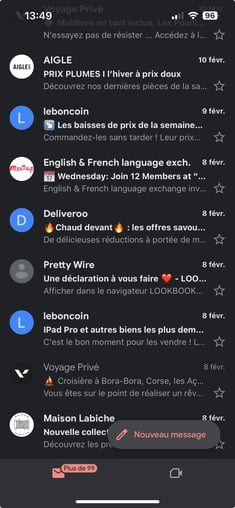
Aigle and Voyage Privé have configured BIMI, which allows them to display their logos from the Gmail inbox, providing more brand visibility.
The subject and preheader as email teasers
The subject and preheader are two other parts of the email header that are crucial for soliciting interest, encouraging opens and therefore maximizing the engagement rate. Their importance lies in their ability to encourage recipients to open the message and explore the content. The main goal of these elements is to provide a clear, relevant and attractive preview of the email so that the user will continue reading.
To achieve this, a few best practices need to be followed. First, subject lines need to be short, concise and eye-catching, attracting the recipient’s attention in a few words. Using emojis, personalization or even asking questions can attract attention and encourage the user to open the email. Subject lines need to be informative and clearly indicate the subject and main purpose of the email.
The use of relevant keywords and attractive value propositions can help strengthen the attractiveness of the subject line. But be careful not to make any misleading promises in the subject line just to earn opens; this will discredit the brand and cause discontent amongst your users.
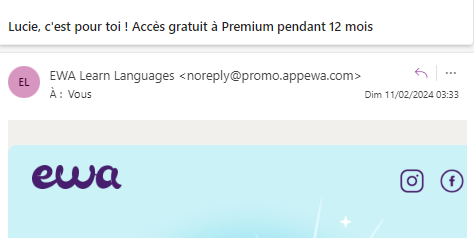
Here Petco puts the promotion’s $15 OFF benefit directly in the subject line to encourage customers to open the email. Plus, by adding “Grab it before it’s history,” Petco creates a feeling of urgency, and the FOMO (fear of missing out) effect is used so that recipients feel afraid of missing out on the promotion and quickly open the email.
In terms of pre-headers, they offer an additional opportunity to capture recipients’ attention by providing a complementary statement to the email subject line. Pre-headers must complete the subject line by providing additional information or highlighting a special offer. They can also be used to arouse the curiosity of the recipient and incite them to take action.
![]()
Petco uses the pre-header to complete the email subject line and reinforce the feeling of urgency.
Indicating the promotion’s end date supports the FOMO effect previously provided in the subject line, which will incite users to open the email the same day to take advantage of the offer.
To summarize, the subject line and preheader represent an important first impression for recipients. They must be complementary and consistent with the contents of the email. Together with BIMI, they guarantee optimal visibility right from the inbox. Together these three elements increase not only the chances that the email will be opened, but also promote good engagement rates.
|
Best practices/tactics to keep in mind: - Keep the subject line and preview text short so they display well on both desktop and mobile - Put your keywords at the start if you can’t keep the text very short - Ensure the subject line and preview text are coherent and work well together - Attract attention by using personalization, questions or emojis - Avoid using messages that are overly promotional, which could lead to their being marked as spam |
A persuasive email message will generate engagement
The body of your email message is the heart of your email marketing campaign, offering a unique opportunity to convince and engage recipients. To maximize the impact of this main message, a few key elements need to be taken into consideration.
A clear and convincing value proposition
The value proposition is the foundation of the main message in any successful email communication. It represents the main offer or central benefit the user can expect from the content of the email. It must be visible as soon as the email is opened. An effective value proposition lets you capture the attention of recipients, clearly communicate the advantages of your product or service, elicit their interest and incite them to take action.
For a value proposition to be persuasive, it needs to be believable: “I believe that what they are telling me is clear,” “What will I gain by reading/clicking?” The proposition must be adapted to the audience: “Does it fulfill my needs?” It also helps differentiate the brand from competitors by highlighting its unique advantages: “I can’t get this anyplace else.”
A value proposition that fulfills all of these best practices can significantly increase your click and conversion rates.

The value proposition for this email is visible and clear from the moment it is opened. Withings offers its users control over what is “vital” through its products. The solution is shown in its entirety, then each section highlights each related product with its benefit emphasized in the subtitle. Even when you read the email quickly, the value proposition and benefits of Withings products are clear and inspire users to want to continue their experience.
|
A few best practices/tactics to keep in mind:
|
Make call-to-action buttons easily locatable so the user can continue their experience
After the value proposition comes the call-to-action buttons, which are also essential elements to support an email’s engagement rate. Users who are persuaded by the value proposition need to have access to easily locatable and accessible call-to-action buttons to be able to continue their experience. One best practice is to have a main button generally located above the fold, as well as secondary buttons.
To ensure optimal visibility, call-to-action buttons must be clearly marked as buttons and distinguishable from the rest of the email body with highly contrasting background colours. When easily locatable, they stand out from the body text of the email. The user can therefore quickly decide to click on it to continue their experience.
Text on buttons must use action verbs and clearly transcribe what the action triggers by clicking, which encourages recipients to do something specific. For example, instead of “Click here,” it’s better to opt for lines such as “Download now” or “Sign up today.” These action verbs clearly direct recipients to take a desired action, thereby increasing your chances of conversion and engagement.

In this AirBnB email, the call-to-action buttons are clearly indicated and the primary (pink) button stands out due to its colour and position from the other secondary “white” buttons. The text on the buttons incite the user to click to continue their experience. The text of the main button, “Take me there,” incites the user to click by suggesting that doing so will bring them closer to the promise made in the title, “Sip back and relax.”
|
A few best practices/tactics to consider: - Use call-to-action buttons that are clearly indicated and immediately visible - Use text on buttons to allow users to understand what they should expect after clicking - Use different button designs for primary and secondary calls to action - Use a limited number of buttons |
Email personalization to create lasting and engaging relationships
Email personalization is a lot more than just a fun added touch; it’s a powerful strategy that transforms interactions with recipients into tailored experiences. This approach involves adapting the content and messages of emails based on recipients’ personal data, such as their preferences, past behaviour and even their first names.
By personalizing these emails, companies create more significant and memorable interactions with recipients. For example, by including the name of the recipient in the body of the email, they will feel that they are being addressed directly, thereby strengthening the connection between the recipient and the brand. Similarly, by offering product recommendations based on the recipient’s past purchases, emails become not only more relevant, but also more likely to generate additional sales.
Plus, email personalization contributes to humanizing communications between brands and customers. By showing that the company understands the individual needs and preferences of each recipient, it strengthens the trust and satisfaction of customers, thereby promoting long-term loyalty.
Email personalization lets you establish long-term relationships by adapting the email content to the individual needs and preferences of the audience, which will engage the audience and encourage their loyalty in the long term.
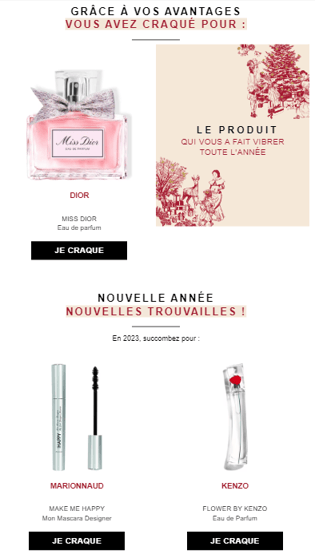
Marionnaud personalizes the email with products already purchased by the customer, reinforcing the feeling of a personalized relationship and a product proposal closer to the target's needs. In this case, by proposing previously purchased products, Marionnaud encourages customers to repurchase products they have already tried out, thus facilitating the act of purchase and maximizing the e-mail's conversion rate.
An email design that facilitates understanding and drives the value proposition
Email design plays an essential role in the creation of an engaging user experience. This covers not just the visual appearance, but also the placement of elements, typography, colours and interactive elements. Email design lets you attract the attention of recipients, effectively communicate the message, strengthen the brand’s image and incite recipients to take action.
Well-considered email design can generate a number of positive effects. First, it creates a favourable first impression that also strengthens brand credibility and encourages trust in recipients. In addition, an intuitive, well-structured design makes rapid understanding of the message easy and guides recipients to take the desired action, whether that is making a purchase, signing up for a newsletter or downloading content.
The importance of email design lies in its direct effect on recipients’ engagement and on the results of email marketing campaigns. Careful design adapted to recipients’ needs can significantly increase click and conversion rates. Design that is coherent with the brand image strengthens brand recognition and recall, thereby contributing to establishing a lasting relationship with customers.
Email design is a lot more than merely aesthetics; it’s a key element in every email marketing strategy. By investing in attractive, functional design that is coherent with the brand, companies can improve engagement of recipients, strengthen their brand image and increase the effectiveness of their email campaigns.

In this email from Airbnb, the design gets the right messages across and captivates the user with its promise. The bold headline in large type ''take it outside'' calls out, and the injunction used in the title gives the impression of having no choice but to want to get out and enjoy the great outdoors/nature to recharge one's batteries.
The Hero Image photo is in Instagram format and gives the impression of a carousel, making the user want to see the other photos, as in an Instagram publication. What's more, the use of the Instagram format suggests that the locations are beautiful enough to end up on the user's Instagram profile. The aim of the email is to introduce the user to the 56 categories offered by Airbnb by showing them a preview in the email, and the call-to-action buttons support this aim with the main (black) button located at the bottom of the email in the section for categories.
A footer that complies with legislation and guides the user
The footer can take several forms, but it is always a permanent element of email campaigns, along with the header. The footer lets you provide additional information about the company, but above all, it contains the unsubscribe link.
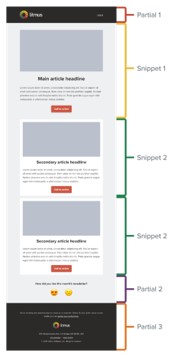
In this email, the “Partial” modules are email elements that don’t change and are reusable for each email communication. The footer (Partial 3) is identical for every email.
There are a few obligatory legal elements that must be included in the footer, such as the unsubscribe link, but also three elements required by Law C-28, which are the mailing address of the business, the phone number and the contact email address.
In addition to these obligatory elements, the footer can be used to provide useful information. It can contain links to the company’s social media accounts or even provide more guidance to users by allowing them to locate answers to their questions (F
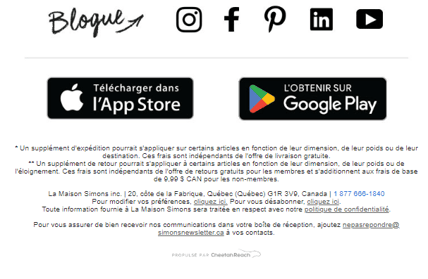
A footer that contains the unsubscribe link complies with Law C-28 (company address, contact) and redirects to the privacy policy. It also contains legal information, such as the company’s delivery policy. The footer is also used to highlight Simons’ social media accounts and its app.
Email that respects accessibility criteria for an optimal user experience
The accessibility of the email is essential for guaranteeing an optimal experience for all recipients, whatever type of inbox or device they use. It also contributes to improving email deliverability by avoiding anti-spam filters that may penalize emails that don’t conform with accessibility requirements.
Responsive email for reading on any device
These days, it’s essential to design emails for reading on mobile. Responsive email design guarantees that they are automatically adapted to different types of devices, whether a computer, tablet or phone. This allows the content to remain readable and attractive in its presentation, whatever display format it appears on, and therefore guarantees a good experience for the user.
Alt text on images to facilitate comprehension
Certain messaging apps can block images, or the images may not load when the email is being read. That’s why adding an alternative description for each image is important. It lets recipients understand the content of the email, even if the images are not displayed.
A backup font to fulfill standard font requirements of email clients
Certain fonts are not compatible with messaging clients. When a font is not compatible, the messaging client will automatically replace it with something else, without no possibility of choosing which font is used as the replacement. It is therefore necessary to research which fonts are accepted by your audience’s messaging applications so you can configure a backup font that matches the company’s chosen font as closely as possible.
How the size of HTML code and optimized images affects user experience
The size of HTML code and images can have a significant impact on the performance and deliverability of the campaign. The weight of HTML code refers to the quantity of code used to build the structure and style of the email, while the weight of images refers to the file sizes of images included in the email.
Weighty HTML or images can lead to longer email loading times, which may frustrate recipients and lead to lower open and conversion rates.
Plus, message apps may consider heavy emails as spam and filter or block them out, which can compromise campaign deliverability. Certain messaging clients like Gmail limit the weight of code to 102 K. Once you exceed this limit, the email is truncated in the inbox, which does not produce an optimized user experience.
To reduce the weight of HTML code, avoid using irrelevant tags, minimize the use of inline styles and optimize code to make it as light and efficient as possible. For images, it’s important to compress them without compromising their visual quality, using optimized image formats like JPEG or PNG, and limit the number of images and their sizes in the email.
Test emails before sending them
Besides these best practices, you should remember to test your emails before sending them. Most email creation platforms let you preview the email, but this feature often doesn’t adequately represent the final result seen in email inboxes.
Send test emails to yourself at different addresses (a Gmail address, a Yahoo address, an iCloud address and an Outlook or Live address) and open them from several different email inboxes (the Gmail app for mobile as well as the online version, Apple Mail’s mobile and desktop app versions…). This will let you quickly identify major mistakes that affect recipients’ experience.
However, this kind of testing may take some time and you might be performing tests that are useless and irrelevant in your situation. The best approach is therefore to identify which email inboxes are most used by your recipients (via campaign reports or more advanced email analytics tools such as Litmus) and also use email testing tools such as Litmus or EmailsOnAcid. The latter two tools let you verify the results that appear in inboxes very quickly.
However, these platforms will not allow you to test certain aspects that are important in the testing phase: the launch of automated emails and personalization. To verify these before sending, you must use features found directly in your sending platform to test different rules that trigger emails and personalization conditions.
Beyond best practices
The application of best practices to email design is an essential component for a successful CRM strategy and a simple way to optimize your campaigns. If you have already followed all these best practices, optimization of your strategy will involve the addition of new tactics.
Whether you’d like to evaluate your campaign models or your emailing strategy and CRM more generally, our teams are available to assist you.












